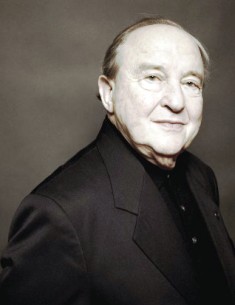
Pressler Warms Hearts at Linton Series Fans

Menahem Pressler
|
Music is for life.
How clear
this is, and how heart-warming, when you hear someone like pianist Menahem Pressler.
Pressler, 87, founding member of the legendary Beaux Arts Trio (now disbanded), made his debut on Cincinnati’s Linton Chamber Music Series Oct. 23 at First Unitarian Church in Avondale. A member of the faculty of the Jacobs School of Music at Indiana University in Bloomington, Pressler performed with violinist Alexander Kerr, violist Paul Neubauer and cellist Eric Kim. Kerr, former concertmaster of both the Concertgebouw Orchestra in Amsterdam and the Cincinnati Symphony Orchestra, is also on the IU faculty, as is Kim, former principal cellist of the CSO. Neubauer, who also made his Linton debut, performs for the Chamber Music Society of Lincoln Center. They made an arresting ensemble.
A full house was in place for the concert, which was held in conjunction with the inaugural Constella Festival of Music and Fine Arts.
On the program were piano quartets by Mozart, Joaquin Turina and Dvorak, plus an encore and a generous insert by Pressler. The insert was Chopin’s Nocturne in C-sharp Minor, Op. posth., performed in honor of Anne Black, Linton board member and former president, who was presented a plaque following intermission. (Black did not know Pressler would perform, she said, slightly overwhelmed by the tribute.)
Mozart’s Quartet in G Minor, K.478 (1785), demonstrated the ensemble’s strengths right away. Pressler took delight in aligning his performance with the strings, lines were discrete, and Kerr and Neubauer’s tone quality blended so well that in the middle register, one might mistake one for the other.
Spanish composer Joaquin Turina’s Quartet in A Minor, Op.67 (1933), delivered a healthy dose of Andalusian flavor. Kerr phrased the opening theme graciously, while Kim’s solo moment against “icy” string tremolo (Kerr and Neubauer playing sul ponticello or "on the bridge") later in the movement was hauntingly evocative. The second movement (Vivo) began pizzicato, like a big guitar, and Kerr put a touch of bravado into the cadenza-like opening of the finale.
Dvorak’s Quartet for Piano and Strings in E-flat Major (1889) was heard after intermission. It is a big, expansive work with lots of melody and gesture. Again, Kerr displayed exquisite tone production, invariably matching his instrument to the musical moment. The second movement (Lento) overflowed with melody, beginning with a lengthy passage for cello, beautifully rendered by Kim. The endearing third movement (Allegro moderato, grazioso) gave way to a brilliant Finale, with high-spirited, well-matched playing by all.
Responding to a persistent standing ovation, the quartet performed the slow movement of Brahms’ Piano Quartet No. 3 in C Minor, a “love song,” said Pressler who, as he did all afternoon, invested lots of it in his playing.